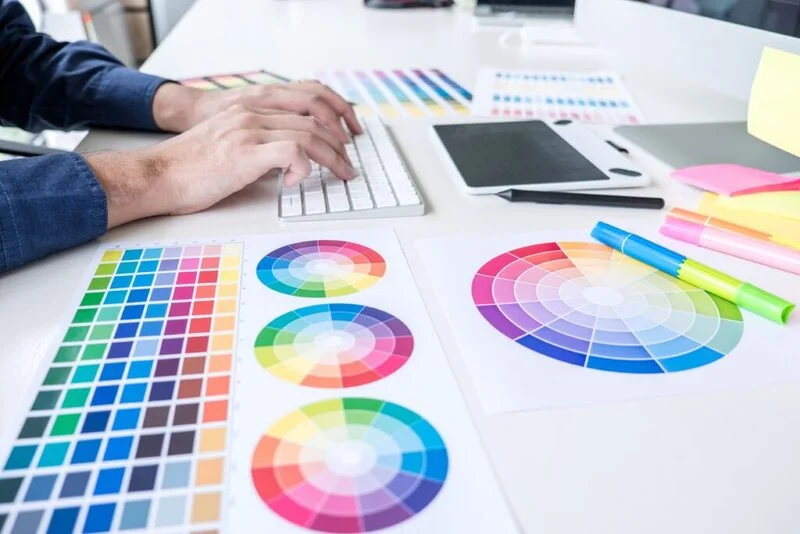In a sea of black and white, a touch of color can make all the difference. When it comes to resumes, such value also applies. Rise above other job searchers with the help of a well-designed resume. Learn how to add color in resume —and make your job application stand out!
In this article, we will explore the value of adding colors in a resume, along with tips in using hues to convey professionalism and personality. Let’s dive in.
The Impact of Color on First Impressions
Color psychology holds immense power in shaping the perception of professionalism and personality. Gone are the days of monotonous documents; today’s job seekers are turning to the art of color to make their resumes stand out from the crowd.
But how do you choose the right hues to convey the right message? When used correctly colors can impact audiences both psychologically and emotionally. This explains why, as a job seeker, you need to be strategic with using colors in a resume to leave lasting — and positive — impression.
Research has shown that color has a significant impact on how individuals perceive and interpret information. This also applies in resume writing. When reviewing a resume, recruiters and hiring managers form initial impressions based on visual cues, and color in resumes plays a crucial role in this process. By understanding the impact of color on first impressions, job seekers can strategically use hues to create a positive initial perception.
For example, shades of blue are often associated with trust, reliability, and competence, making them ideal for conveying professionalism. On the other hand, vibrant and warm colors like orange and yellow can evoke feelings of energy, creativity, and enthusiasm, making them suitable for showcasing personality.

Understanding the Meaning of Different Colors
To effectively use color in resume, you need to have a comprehensive understanding of the meanings and associations attached to different colors. Knowing how each color can impact your audience will help you communicate their desired message strategically.
Here are some common colors and their meanings:
- Blue: Often associated with trust, reliability, and competence. Blue holds the distinction as a universally accepted color in professional settings, making it an excellent choice to convey professionalism.
- Red: Signifies passion, energy, and power. It can be used strategically to draw attention and create a sense of urgency. Use it sparingly, however, as an excess of this color can evoke feelings of aggression or dominance.
- Green: Associated with growth, harmony, and balance. Green conveys a sense of freshness as well as adaptability and a positive attitude toward change. The color also applies to industries related to the environment and sustainability.
- Yellow: Symbolizes happiness, optimism, and creativity. Yellow is a vibrant and energetic color that can convey a positive and outgoing personality. As with red, however, use yellow in moderation, since its overuse can be overwhelming.
- Purple: Often associated with creativity, wisdom, and luxury. Purple is used when you wish to express a sense of uniqueness and sophistication. The color is also perfect for individuals in the creative fields.
Advantages of Using Color in a Resume
Draws Attention
Hiring managers receive a handful of resumes and cover letters each day. So, there is a high chance that you are competing with a hundred other job searchers for a single job post. Set yourself apart from the pile of applicants using a unique resume. One way to catch their eyes is through a well-made design using colors in resume.
Improves Layout
After standing out from other job searchers, your next challenge is to let them see your winning feats. If done right, resume colors and layout can do this trick. Hiring managers may quickly scan your document so you must be able to highlight your topnotch skills within a short time. Also, colors can provide a smooth transition to your sections and improve your entire resume layout.
Shows Creativity
Applying for jobs in a creative industry? You may want to start strong with a creative resume. Showcase your skills with colors and design through your resume. Choose the right hues, best resume fonts, and resume layout based on your job post. If the company uses a color scheme, you may also want to use it. This can show that you did your research prior to the job search.
Disadvantages of Using Color in a Resume
Affects Readability
There are hiring managers who use software, such as applicant tracking systems, to screen through the resumes they receive every day. The system scans the resume to find keywords for a job role. At times, an overly designed resume may not be scanned properly. Nonetheless, using more graphics or mismatched colors over words may affect this process.
Distracts Reading
As said previously, adding colors can improve the resume layout. However, if done wrong, it can also make your resume difficult to read. Thus, choose colors that would match your tone. Also, select areas that need more emphasis and focus the colors on those parts to achieve balance on colors, white background, and texts.
Using Colors to Convey Professionalism
When it comes to professionalism, certain colors are more effective than others. As mentioned earlier, blue is a go-to color palette in professional settings. Its associations with trust, reliability, and competence make it an ideal choice for individuals looking to create a professional impression.
With this in mind, incorporating shades of blue into your resume can help communicate to your readers your utmost professionalism and competence. Additionally, using a neutral background color, such as white or light gray, can help create a professional and polished appearance.
Conversely, avoid using overly vibrant or attention-grabbing colors in resume when aiming for a professional look. Colors such as red, orange, or bright yellow can be perceived as distracting or unprofessional in certain industries. While these colors can be used strategically to draw attention to specific elements, it is important to use them sparingly and in a controlled manner.
Using Colors to Convey Personality
In addition to conveying professionalism, colors in resume can also be used to showcase personality and individuality. Depending on the industry and the desired impression, you can use colors to communicate your personal brand and unique qualities. If you are in a creative field or looking to showcase your innovative thinking, vibrant colors like purple, orange, or yellow can help convey a sense of creativity and originality. These colors can be incorporated into headings, accent elements, or even the overall design of the resume.
On the other hand, if you exude a more conservative or traditional personality, you can go for more subtle colors such as shades of gray or muted tones. These colors can still add visual interest to the resume while maintaining a professional and understated appearance.
Expert Tip:
Strike a balance between showcasing personality and maintaining a professional image, ensuring that the chosen colors align with the desired impression and industry norms.
Choosing the Right Colors for Your Resume
Now that we have explored the impact of color and the meanings behind different hues, it is time to choose the right colors for your resume. The color palette you select should align with your desired message, personal brand, and industry norms. Here are some tips to help you make the right color choices:
1. Research industry norms.
Different industries have respective expectations when it comes to resume design. Thus, researching industry norms can help you understand whether a more conservative or creative approach is appropriate.
2. Consider your personal brand.
Your personal brand plays a significant role in the color choices you make. With this in mind, consider the qualities and values you want to represent and choose colors that align with your personal brand.
3. Use color as an accent.
Instead of using color throughout the entire resume, consider using it as an accent to draw attention to specific elements. This can help maintain a professional appearance while still incorporating color strategically.
4. Test different color combinations.
Experiment with different color combinations to find the ones that work best for you. Consider using online color palette generators or seeking inspiration from design resources to find harmonious color schemes.
5. Seek feedback.
Once you have chosen your color palette, seek feedback from trusted friends, mentors, or professionals in your industry. Their input can provide valuable insights and help you make any necessary adjustments.

Common Mistakes to Avoid When Using Color in Resumes
While color in resumes can be your powerful ally toward a successful job search, there are some common mistakes that you need to avoid. Here are a few:
1. Don’t use too many colors.
Using too many colors can create a chaotic and unprofessional appearance. Stick to a limited color palette to maintain a cohesive and streamlined design.
2. Be wise with color combinations.
Using colors that clash: Clashing colors can be visually jarring and distract from your resume’s content. Ensure that the colors you choose complement each other and create a harmonious look.
3. Take note of the industry norms.
While it is important to showcase your personality, it is also essential to consider industry norms. Using colors that are completely outside of industry expectations may not be well-received by recruiters or hiring managers.
4. Don’t sacrifice readability for aesthetics.
While aesthetics are important, readability should never be compromised. Ensure that the colors you choose provide enough contrast with the background and text to ensure clarity and legibility.
Expert Tip:
The goal is to create a visually appealing and professional resume that effectively communicates your message and stands out from the competition. Hence, use color in resumes strategically, done with purpose and consideration.
Leveraging Color Psychology for Resume Success
Color psychology plays a significant role in shaping the perception of professionalism and personality, and this includes job search tools such as resumes. By understanding the emotional and psychological impact of different colors, job seekers can strategically use the right color in resume that not only catches the eye, but also leaves a lasting impression.
Nevertheless, when choosing colors in resume, it’s important to consider the industry norms, personal brand, and desired message. By incorporating color strategically into the overall design and avoiding common mistakes, you can create visually appealing and impactful resumes that stand out from the competition.

Perfect Your Job Search with the Right Color in Resume
Embrace the power of color and leverage color psychology for a job-winning resume! Partner with a resume writing expert to help you add the right color in a resume. Gain a significant competitive edge in today’s job competition and use the latest resume trends to your advantage. Contact us to learn the best resume offers for you!








